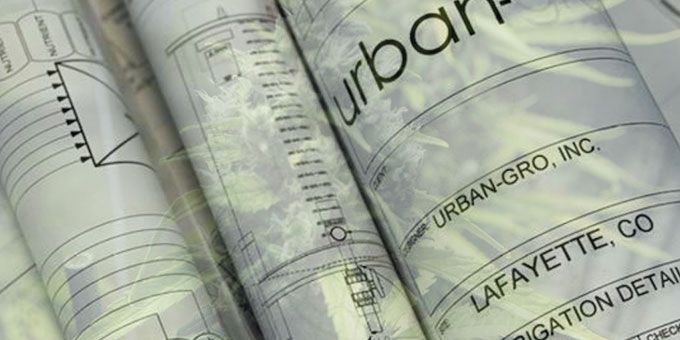The most important elements to consider in your design are the interactions between what we call the 3 P's—people, plants, and products. Carefully calculate factors like fertigation, HVAC, staff, and technology.
 Building a Project Plan for Commercial Grow Facility Design
Building a Project Plan for Commercial Grow Facility Design

Article from | urban-gro
Building a project plan for executing your commercial grow facility design starts before you even obtain a license. Sure, you need to be licensed to grow, but if you line up all your project planning during the license application process, once you’re granted your license, you can immediately put your project plant to work. Remember, the best commercial grow facilities aren’t necessarily designed based on total canopy square footage, but rather, on the overall scalability and efficiency of operations. The most important elements to consider in your design are the interactions between what we call the 3 P's—people, plants, and products. Carefully calculate factors like fertigation, HVAC, staff, and technology to plan precisely how they will integrate into and safely interact inside your space. Read on to get a better understanding of how to develop a project plan for your commercial grow facility.
Grow Operations: How it Works
Where do I even start?
To a large extent, your facility will be influenced by your budget, so start by determining how much you can realistically invest in a facility (or raise). Your budget will help determine whether you pursue a new construction or retrofit, the type of equipment you ought to consider, and your anticipated staff size. Bear in mind that all of these decisions come with positives and negatives, for instance, constructing from scratch, while allowing you to customize every square foot, may delay your entrance into the market (sometimes for years). You’ll also need to carefully consider CAPEX versus OPEX costs of equipment—while a system may be less expensive out of the box, you may ultimately pay more over time in maintenance costs and unrealized yields. Even before you've selected a site, it will benefit you greatly to hire a team of experts who can help with everything from building analysis to design concepts that will ultimately help you build and execute a successful project plan.
How much is it going to cost?
Your project costs will vary depending on the type of facility you create and your region. Ground-up builds can cost millions by the time you’re actually growing plants; however, a general ballpark figure is between $350–$450 per square foot for the build-out. In addition, make sure you factor in land lease costs, taxes, licensing fees, and utility costs to get a more complete picture of the upfront CAPEX requirement.
Do I need to bring in a bunch of different companies to work together?
The short answer: no. That said, you will need to work with different specialists to get it right: A cultivation consultant, an architect, a mechanical engineer, a general contractor, a structural engineer, and an environmental engineer, to name a few. However, if you go with an integrated, turnkey solution such as the one offered by urban-gro, you can save yourself the headache of managing multiple consultants with a simplified single point of contact while resting assured that all your bases are covered by experts who are collaborating at each step.
How many staff members do I need?
It depends on the scale of your operation, the degree to which your systems are integrated and automated, and your growing goals. An efficiently designed and built commercial grow facility ought to be optimized to the extent that you only need key staff members to run the operation, including your lead grower.
Cultivation Systems You Should Include in Your Commercial Grow Facility Design
How does facility design inform equipment selection?
Your facility design will have a huge influence on your equipment selection. The volumes of your spaces, racking style, and square footage all factor into what equipment will work best for your facility. This is why it’s important to start with design versus starting with brand names. It’s critical that your key systems are integrated and work together to ensure a consistently optimal growing environment. Just because you love the look of a certain light fixture or racking system doesn’t mean it’s the best solution for your grow.
How do I make sure my equipment is properly sized and spec’d?
Consult with experts who have a proven track record of success. You don’t want to undersize or oversize equipment. In the case of the latter, you’re putting yourself at risk of incurring unnecessary costs, whereas, with the former, you’re running the risk of hitting capacity limits short of projected output calculations and being stuck having to retrofit equipment down the line. It’s so much easier and more cost-efficient to simply get it right the first time by not making the same mistakes as those who came before you.
How do I know I’m getting the best pricing?
The easiest way to get the best pricing is to not go it alone. Work with a team that has a proven procurement process and established relationships with vendors. These partners negotiate the most competitive pricing on your behalf thanks to their purchasing power and ability to buy in bulk.
What do I need to know about bench system basics?
Benching comes in single-tier, multi-tier, fixed, and rolling. With many options to choose from, all of which claim to be “the best,” it makes sense to work with a designer who will model your unique space and design a benching plan that transparently projects overall canopy square footage and function.
What do I need to know about fertigation basics?
The idea of “fertigation basics” is a bit of an oxymoron. The fact of the matter is that fertigation is complicated. From the actual delivery of water and nutrients to the management of wastewater and runoff—there are major factors to consider like costs, regional regulations, and automation. Fertigation systems run the gamut from fairly manual to highly technologically advanced. The best way to understand what’s right for you is to partner with a firm that not only understands your options but also knows the rules in your market regarding what can and can’t go down the drain.
What do I need to know about lighting basics?
Lighting is another area that is more or less a science. In order to properly light your facility, it’s critical that you understand metrics like PPFD, wattage, and heat load (to name a few). Traditional HPS fixtures can be a budget-friendly option but will produce more heat, requiring your HVAC system to compensate, whereas LED fixtures produce less heat but there is mass performance variability in the market and what you see isn’t necessarily always what you get.
What do I need to know about HVAC basics?
Selecting an HVAC system for your grow facility isn’t like selecting a unit for your home or even a commercial building like an office. The HVAC requirements of a grow facility are unique and demanding. It’s critical that you go with a purpose-built HVAC system inside your grow to properly manage key environmental factors like temperature, vapor pressure differential (VPD), CO2, and humidity.
How to Create a Commercial Grow Facility Project Plan
How do I obtain a license to grow?
This will vary from state to state, but you can start by reading up on the requirements in your area online. A cannabis lawyer or cannabis compliance specialist can help guide you through the more detailed application process.
After I get my grow license, where do I go from there?
While some parts of this process may seem confusing or overly complicated, there is a proven path to follow from concept through build-out. While every facility is unique, the basic roadmap includes the following steps::
- Site selection— Determine where you will locate your grow facility
- Feasibility study— In compliance with local regulations, perform a feasibility study
- Design/architecture— Once your site has been green-lighted, you can begin to design the space
- Engineering— Your facility layout and construction design will be used to design the engineering specifications
- Equipment specification and procurement— With your engineering design as a guide, equipment selection and procurement is next
- Construction Management— A general contractor will come on board to oversee construction
- Equipment integration— Equipment will be installed and then integrated so that all the parts work as a whole
- Facility commissioning— The facility will be inspected and commissioned so that production is allowed to begin
- Personnel training— Staff will be trained on procedures and technical operation of all equipment
- Ongoing operational support— Day to day monitoring and maintenance will ensure that all goes according to plan. For additional support and training, a gro-care type program can save time and resources.
Getting Started
New growers can find the many moving parts of commercial grow facility design overwhelming. But with a little support and expert guidance, the entire process can be made straightforward. If you want to learn more about urban-gro's turnkey services, contact us today and see how you can gro profits.
The content & opinions in this article are the author’s and do not necessarily represent the views of AgriTechTomorrow
Comments (0)
This post does not have any comments. Be the first to leave a comment below.
Featured Product

